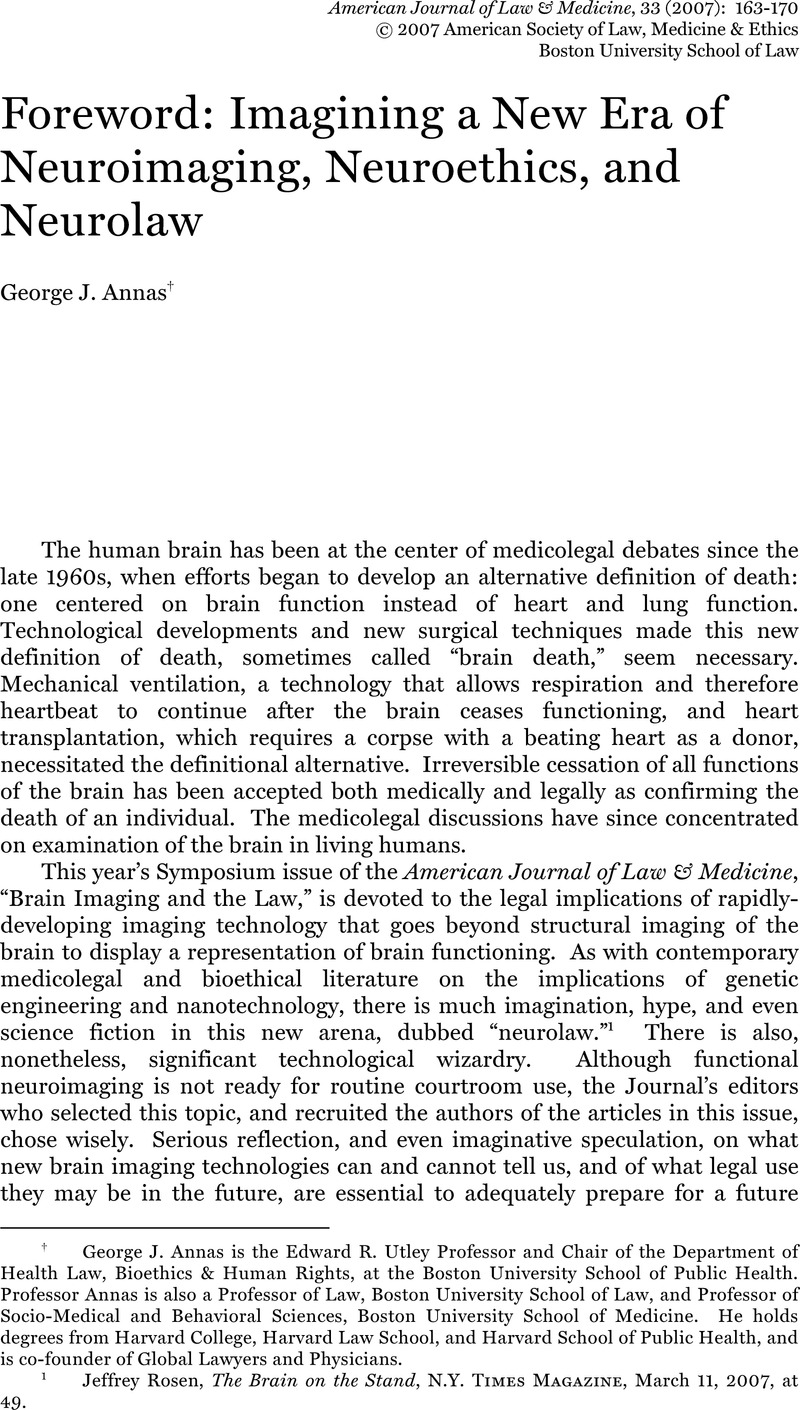Published online by Cambridge University Press: 06 January 2021

1 Jeffrey Rosen, The Brain on the Stand, N.Y. Times Magazine, March 11, 2007, at 49.
2 See, e.g., Ronald E. Cranford Institutional Ethics Committees and Health Care Decision Making (Edward A. Doudera, ed., 1984); Cranford, Ronald et al., Uniform Brain Death Act, 29 Neurology 417 (1979)CrossRefGoogle Scholar; Ronald E. Cranford, The Spring Case and the Importance of Interdisciplinary Dialogue, Medicolegal News, Feb. 1981, at 17.
3 Conference on the Terri Schiavo Case: One Year Later, held by the Boston University School of Law (Mar. 31, 2006), available at http://www.bu.edu/law/events/audio-video/shiavo.html.
4 Id. (providing links to the entire conference, including Ron Cranford's speech).
5 Id.
6 Id. See also Ronald Cranford, The Persistent Vegetative State: The Medical Reality (Getting the Facts Straight), Hastings Center Report, March 1988, at 27-32.
7 Brophy v. New England Sinai Hosp., 497 N.E.2d 626 (Mass. 1986).
8 Cruzan v. Dir., Mo. Dep't of Health, 497 U.S. 261 (1990).
9 In re Busalacchi, 1991 Mo. App. 315 (1991).
10 In re Rosebush, 491 N.W.2d 633 (Mich. Ct. App. 1992).
11 In re Martin, 538 N.W.2d 399 (Mich 1995).
12 Conservatorship of Wendland, 28 P.3d 151 (Cal. 2001).
13 Conference on the Terri Schiavo Case: One Year Later, supra note 3. See, e.g., Broder, Andrew J. & Cranford, Ronald E., ‘Mary, Mary, Quite Contrary, How Was I to Know?’ Michael Martin, Absolute Prescience, and the Right to Die in Michigan, 72 U. Det. Mercy L. Rev. 787 (1994)Google Scholar; Nelson, Lawrence J. & Cranford, Ronald E., Michael Martin and Robert Wendland: Beyond the Vegetative State, 15 J. Contemp. Health L. & Pol’y 427 (1999).Google Scholar
14 In re Schiavo, 851 So. 2d 182 (Fla. Dist. Ct. App. 2003).
15 E.g., Annas, George J., ‘I Want to Live’: Medicine Betrayed by Ideology in the Political Debate over Terri Schiavo, 35 Stetson L. Rev. 49 (2005)Google Scholar; The Case of Terri Schiavo: Ethics at the End of Life (Arthur L. Caplan, James J. McCartney & Dominic A. Sisti, eds., 2006); Michael Schiavo & Michael Hirsh, Terri: The Truth (2006); Mary Schindler & Robert Schindler, A Life That Matters: The Legacy of Terri Schiavo—A Lesson for Us All (2006).
16 Senator Majority Leader Bill Frist, Floor Statement on Terri Schiavo Bill (Mar. 17, 2005) available at http://www.nationalreview.com/comment/frist200503181027.asp.
17 151 Cong.Rec.H712-H713 (statement of Sen. Phil Gingrey).
18 151 Cong.Rec.H7115 (statement of Sen. Dave Weldon).
19 Conference on the Terri Schiavo Case: One Year Later, supra note 3.
20 Judge Greer also spoke at the Schiavo conference.
21 Cranford, Ronald, Facts, Lies, and Videotapes: The Permanent Vegetative State and the Sad Case of Terri Schiavo, 33 J.L. Med. & Ethics 363 (2005).CrossRefGoogle ScholarPubMed
22 The Abrams Report—Terri Schiavo's 2002 CT Scan (MSNBC television broadcast Mar. 29, 2005) available at http://www.msnbc.msn.com/id/7328639/.
23 Jon R. Throgmartin, Report of Autopsy (2005) available at http://news.findlaw.com/hdoc/docs/Schiavo/61305autopsyrpt.pdf.
24 Fins, Joseph J., The Orwellian Threat to Emerging Neurodiagnostic Technologies, 5 Am. J. Bioethics 56 (2005)CrossRefGoogle ScholarPubMed. On continuing attempts to use functional neuroimaging to confirm a vegetative state diagnosis see Owen, Adrian et al., Detecting Awareness in the Vegetative State, 313 Science 1402 (2006).CrossRefGoogle ScholarPubMed
25 E.g., Khoshbin, Laura & Khosbin, Shahram, Imaging the Mind, Minding the Image—An Historical Introduction to Brain Imaging and the Law, 33 Am. J.L. & Med. 171 (2007)CrossRefGoogle Scholar and Baskin, Joseph, Edersheim, Judith & Price, Bruce, A Picture is Worth a Thousand Words: The Role of Neuroimaging in the Courts, 33 Am. J.L. & Med. 239 (2007).CrossRefGoogle Scholar
26 E.g., Tovino, Stacey, Imaging Body Structure and Mapping Brain Function: A Historical Approach, 33 Am. J.L. & Med. 193 (2007).CrossRefGoogle ScholarPubMed
27 Arrigo, Bruce, Punishment, Freedom, and the Culture of Control: The Case of Brain Imaging and the Law, 33 Am. J.L. & Med. 457, 492 (2007).CrossRefGoogle ScholarPubMed
28 Id. at 447 (emphasis in original).
29 Marks, Jonathan H., Interrogational Neuroimaging in Countertorrorism: A ‘No-Brainer’ or a Human Rights Hazard?, 33 Am. J.L. & Med. 483, 483-500 (2007)Google ScholarPubMed; Thompson, Sean Kevin, A Brave New World of Interrogation Jurisprudence?, 33 Am. J.L. & Med. 341, 341-358 (2007)CrossRefGoogle ScholarPubMed. On the use of brain technology in the military, see Jonathan D. Moreno, Mind Wars: Brain Research and National Defense (2006).
30 Greely, Henry T. & Illes, Judy, Neuroscience-based Lie Detection: The Urgent Need for Regulation, 33 Am. J.L. & Med. 377, 377-420 (2007).CrossRefGoogle ScholarPubMed See also, Stoller, Sarah & Wolpe, Paul Root, Emergening Neurotechnolgies for Lie Detection and the Fifth Amendment, 33 Am. J.L. & Med. 359, 359-375 (2007).CrossRefGoogle Scholar
31 Kulynych, Jennifer, The Regulation of MRI Neuroimaging Research: Disentangling the Gordian Knot, 33 Am. J.L. & Med. 295, 295-317 (2007).CrossRefGoogle ScholarPubMed
32 Michel Foucault, The Order of Things 9 (1971).
33 Id.
34 Pettit, Mark, fMRI and BF Meet FRE: Brain Imaging and the Federal Rules of Evidence, 33 Am. J.L. & Med. 319, 319-340 (2007).CrossRefGoogle ScholarPubMed Of course, as Adam Kolber so well demonstrates, it is not just in the courtroom that images may tell us more (or less) than they seem, but in the determination of inherently subjective reality, like pain, as well. Kolber, Adam, Pain Detection and the Privacy of Subjective Experience, 33 Am. J.L. & Med. 433, 456 (2007).CrossRefGoogle ScholarPubMed
35 In re Guardianship of Schiavo, 800 So. 2d 640 (Fla. Dist. Ct. App 2003). See also Cranford, supra note 21, at 363.
36 See, e.g., supra notes 23-24 and accompanying text.
37 Rosen, supra note 1, at 84.
38 Tancredi, Laurence & Brodie, Jonathan, The Brain and Behavior: Limitations in the Legal Use of Functional Magnetic Resonance Imaging, 33 Am. J.L. & Med. 271, 288 (2007).CrossRefGoogle ScholarPubMed
39 Steven Pinker, The Blank Slate: The Modern Denial of Human Nature 179 (2002). Neuroimaging is also being used to study morality. See, e.g., Haidt, Jonathan, The New Synthesis in Moral Psychology, 316 Science 998 (2007).CrossRefGoogle ScholarPubMed
40 Pinker, supra note 39, at 181 (emphasis in original).
41 Conference on the Terri Schiavo Case: One Year Later, supra note 3.
42 Id.